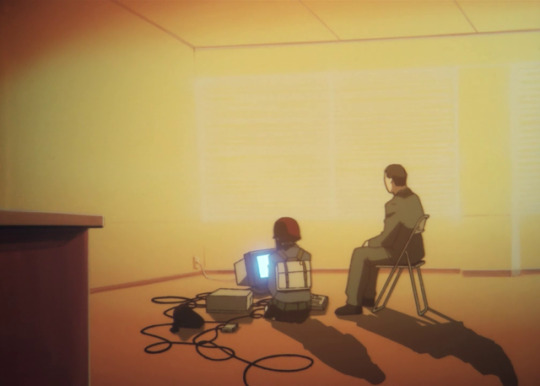Photo



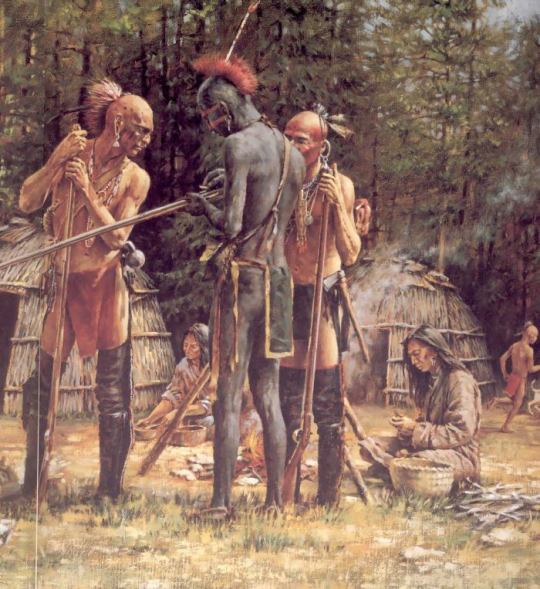

THE COUNCIL OF THREE FIRES AND THE PONTIAC-GUYASUTA UPRISING
Dedicated to: @moonlightramblr, @bulemictoaster, @youreaharrywizard.
This post covers some of the history, culture and religion of the Native American inhabitants of the Great Lakes region of North America, focusing on the Pontiac-Guyasuta Uprising and the Council of Three fires (the Ottawa, Ojibwe and the Potawatomi); the peace-pipe, the Delaware prophets, Rogers’ Rangers, the sport that inspired lacrosse, and some Native battle tactics.
BACKDROP
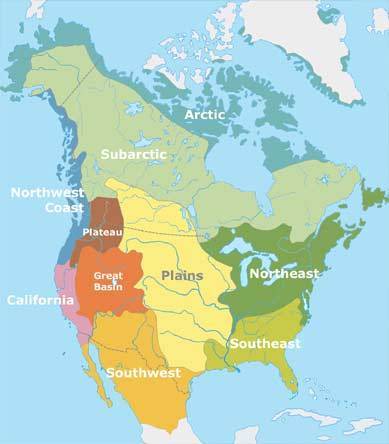
Our story takes place in the northeast Woodlands of North America, around the Great Lakes of Erie, Huron, Michigan, Ontario and Superior. Together these interconnecting bodies of water have about 35,000 islands and make up one fifth of the world’s surface freshwater. The Ohio Valley in the south was home to deciduous (“[leaves] tending to fall off”) woodlands; with trees like maple, oaks and birch. As you progress northward the landscape transitions into dense coniferous forests (“to bear cones”); with trees like cedar, pine and spruce. The natives and later European traders that sailed along the Great Lakes and their many interconnecting rivers would traverse between the latter by carrying their canoes over the land that divided them, this is known as portaging.
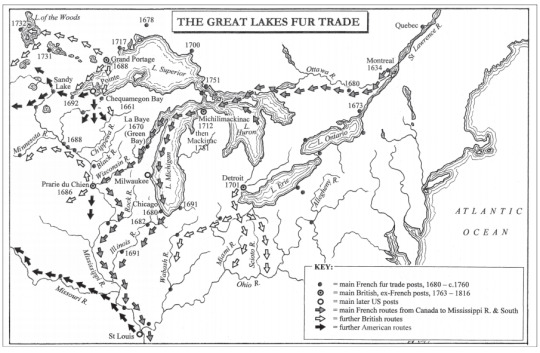
^ The Great Lakes Fur Trade
The hunting game in the north consisted of bears, beavers, moose and caribou while those in the south hunted mostly buffalo (bison), turkey, deer and elk. With the arrival of European traders the natives involved themselves in the lucrative pelt and fur trade, as well as introducing them to the use of canoes, snowshoes and moccasins. The Europeans would trade in alcohol, glass, porcelain, firearms, gunpowder, metal utensils, arrow and spear heads. Major fur trade centers around the Great Lakes built by the French were Niagara in modern New York, Grand Portage in modern Minnesota, as well as Michilimackinac and Detroit in modern Michigan.
The calumet peace-pipe was used in spiritual ceremonies in which the participants would smoke from the pipe and then a prayer would be made; giving respect to the four directions, Mother earth and Father sky. Tobacco was seen as a sacred plant, the smoke that arose from it was believed to assist in sending the prayers to the heavens and the great creator spirit, Gichi-Manidoo. Seeing that these promises, pacts, agreements and prayers were sent up to the great creator spirit Gichi-Manidoo, you can see that they were to be taken seriously.
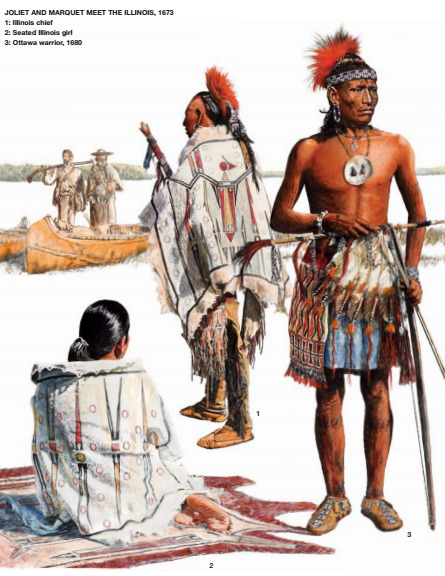
^ Osprey - Men-at-Arms, 467 - North American Indian Tribes of the Great Lakes - Plate A – Right: Ottawa Warrior 1680 (holding a feathered calumet)

^ Lakota (Sioux) ceremonial pipe (chanunpa)
Trade agreements and peace treaties are two common uses; the latter gave rise to its reference as a “peace pipe” by the Europeans. One holding the peace pipe could usually traverse through hostile or enemy territory without facing harm. Once such documented instance occurred in 1673; a French Jesuit missionary named Jacques Marquette is given a calumet peace-pipe, when his group is attacked by Arkansas Natives he lifts the pipe high and the attack halts.
“There remains no more, except to speak of the calumet. There is nothing more mysterious or more respected among them. Less honor is paid to the crowns and scepters of kings than the savages bestow upon this. It seems to be the god of peace and of war, the arbiter of life and of death. It has but to be carried upon one’s person, and displayed, to enable one to walk safely through the midst of enemies -who, in the hottest of the fight, lay down their arms when it is shown. For that reason, the Illinois gave me one, to serve as a safeguard among all the nations through whom I had to pass during my voyage.” – Father Jacques Marquette

^ Osprey - Men-at-Arms, 467 - North American Indian Tribes of the Great Lakes - Plate B – Right: Ottawa warrior, 1755. *Notice the European influences the Natives had by this time, he also wields a hollowed tomahawk used as a pipe

^ Pipe-Tomahawk from the Oglala, Lakota tribe (Sioux)
The Calumet Dance was performed during celebrations, to honor and strengthen peace with foreign visitors, celebrate peace or to unite themselves in this ceremonial dance before war. During the winter this dance would be celebrated indoors but in the hospitable seasons it would be done outdoors, preferably an area surrounded by trees whose shade would offer them shelter from the heat. This ceremonial celebration also included a mock battle done in cadence (rhythm, tempo) with the beating of drums and harmonious singing. One man armed with a war-hatchet, a bow and arrows while the other is armed with a calumet pipe.
“This spectacle is very pleasing, especially as all is done in cadence; for one attacks, the other defends himself; one strikes blows, the other parries them; one takes to flight, the other pursues; and then he who was fleeing faces about, and causes his adversary to flee. This is done so well-with slow and measured steps, and to the rhythmic sound of the voices and drums -that it might pass for a very fine opening of a Ballet in France.” – Father Jacques Marquette’s Journal

^ The Winter Trade by Robert Griffing
Other variants that existed were the medicine pipe and the war pipe. The war pipe was decorated in red feathers which symbolized blood and would be smoked before battle. It is also said that dances were meant to convey the fluidity and spiritual connection between nature, the elements and man. While the Natives used tobacco pipes during trades, the French traders implemented the use of alcohol during trade talks. The natives being either unfamiliar with it or drinking of it only during said trades were easily intoxicated; the European traders used this to their advantage. Under British rule the Natives and the British alike, pushed for the banning of alcohol trade to natives.
Council of Three Fires
The Midewiwin (Midewin), the Grand Medicine society was a secretive religion, the practitioners were called midew and they were thought of as shamans, mystics and medicine men and woman; healers of the body but more so of the spirit. Also seen as great teachers of the old ways, passing on the knowledge of their ancestors between the generations. If practitioners were to follow teachings then they were said to have been promised to live long lives without disease, hunger and conflict. Other shamans are said to have been part of the Mide Society; diviners (tcisaki), healers (nanandawi), fire manipulators (wabena). An important part of a Mide ceremony is when the priest “shoots” the candidate with a medicine pouch which held a “medicine arrow (a shell)”, when struck you were to play dead and then the priest was to symbolically revive you –this resurrection or rebirth was intended to bring health and long life. Ojibwa scholars believe that this was the traditional religion of the Anishinaabeg (Ojibwa, Ottawa, Potawatomi) while European and American scholars view it as a more recent response to contact with the ‘Whites’ and the ensuing troubles that arose such as warfare, disease, alcoholism, and the disintegration of their way of life.

^ Proposed path of the Anishinaabeg
They would etch pictographs with a stylus into bark, metals, stone, and pottery; charcoal could be rubbed into the etchings to make them more visible. One of their uses was to teach and pass on knowledge between generations; subjects like medicine, geographical maps, history, stories and many other sacred ancestral teachings. Some of these scrolls are over four hundred years old. If any of them were in bad enough condition they would be copied or replicated. These scrolls were often hidden away in caves or buried underground.

^ Thunderbird design, inspired by Anishinaabe textiles
From these scrolls we read of the traditional early history of the Anishinaabe people, according to their stories the Anishinaabeg were told by the milgis (radiant beings) that they needed to migrate further inland in order to keep their way of life intact as foreigners would eventually appear and change that. From the Atlantic coast they would migrate further inland along the Saint Lawrence River, until reaching the Michilimackinac straits in the Great Lakes region. They would split up along the way, branching off into different tribes, three of the tribes formed an alliance known as the Council of Three Fires (Niswi-mishkodewin) and Michilimackinac would continue to show significance as a political center for the Anishinaabeg and later as a key fur trade center under the French and British.
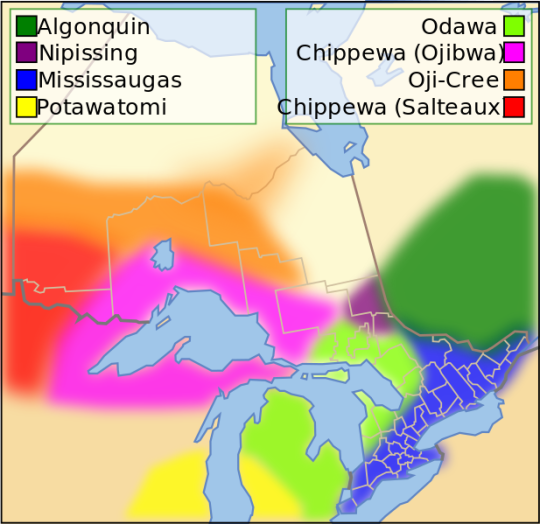
^ Purple: Chippewa (Ojibwe). Yellow: Potawatomi. Light Green: Odawa
The first of the Three Fires and most numerous were the Ojibwe (Chippewa in the U.S. but Ojibwe is used more often in books despite the location so I will continue to use it), who were known as the Older Brother and the Keepers of the Faith as they were the ones that owned the sacred birch bark scrolls. Around the time of their first contact with the Europeans the Anishinaabeg were numbered at about fifty thousand, seventy percent of which were Ojibwe (35,000). Present-day the Ojibwe are one of the largest Native tribes in North America.
The second of the Three Fires were the Ottawa (or Odawa, Ottoway), whose name implies, “to trade”, they were known as the Middle Brother and the Keepers of the Trade as they were extensively involved in trade with the French (Canadians) and the Huron tribe. Trading mostly in tobacco, herbs, medicines, mats, rugs, cornmeal, and most importantly in furs. Monopoly over the fur trade led to a series of conflicts known as the Beaver Wars (beaver pelts in high demand) in which the neighboring Iroquois Confederacy (led by the Mohawk tribe) to the east whom, were armed and backed by the English and the Dutch, attacked the French backed Great Lakes tribes. Trade with the Europeans increased the hunting of animals for their furs and pelts, as their numbers dwindled from over-hunting more conflicts arose as Natives began encroaching on the hunting grounds and territories of others.
The third of the Three Fires were the Potawatomi, whom were titled the Younger Brother and, because they kept the council fire from when they were one tribe, they were called the Keepers of the Fire. It was their responsibility to keep the sacred fire burning and to keep their tradition alive. They were described as warlike and would often join the French in conflicts against the rival Iroquois (Mohawk, Seneca, Huron); even when their brother tribes had allied with the Iroquois and halted hostilities, the Potawatomi continued on. These groups were semi-sedentary; meaning that they stayed in set locations such as villages with birch-bark wigwams (houses) but occasionally (in this case, fall and winter) take on the mobile lifestyle of nomadic hunter-gatherers –they would usually employ the use of the more rapidly assembled tepees. They farmed (beans, peas, corn, pumpkins, tobacco, squash), hunted (deer, elk, bison, bears, beavers), gathered (nuts, berries, maple sap, wild rice, roots) and fished (sturgeon, catfish, pickerel, panfish) along the coasts.
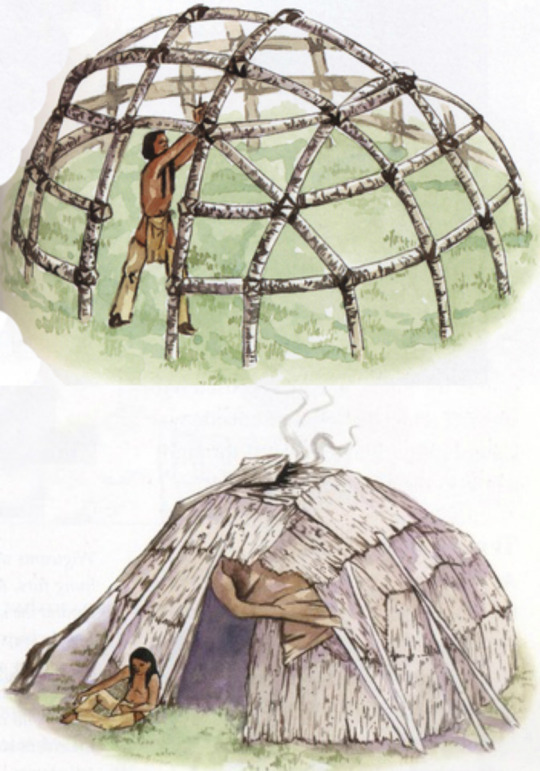
^ Birch-bark Wigwam
Wars with the ‘White Man’
According to the Seven Fires Prophecy, the fourth fire speaks of the arrival of light skinned foreigners, one prophet says that if they come wearing the face of brotherhood and weaponless their will come an epoch of knowledge. The second prophet warns:
“Beware if the light skinned race comes wearing the face of death. You must be careful because the face of brotherhood and the face of death look very much alike. If they come carrying a weapon … beware. If they come in suffering … They could fool you. Their hearts may be filled with greed for the riches of this land. If they are indeed your brothers, let them prove it. Do not accept them in total trust. You shall know that the face they wear is one of death if the rivers run with poison and fish become unfit to eat. You shall know them by these many things.”
According to the fifth and sixth fire, two foreign nations would arrive and if the natives abandon their traditions for those of the foreigners then there would come an era of turmoil, strife and sickness as “All those who accept this promise will cause the near destruction of the people.” Some interpret these two fires as referring to the French and the British respectively. The Sixty Years’ War (1754-1814) is a rarely used name given to a series of conflicts that occurred around the Great Lakes region of North America, five of the six I will name here.
The first of these conflicts was the French Indian War (1754-63), in which the ‘Council of Three Fires’ sided with New France (modern Canada) against the British. Next was the Pontiac-Guyasuta Uprising (1763-65) in which the Natives warred against British America and fourthly the Ottawa would side with the British in the American Revolutionary War (1775-83). The Three Fires, along with other tribes, would side with the Brits against the United States during the Northwest Indian War (1785-95) and once again in the War of 1812 (1812-14).
PRELUDE
The French and Indian War (1754-63)

^ Possessions of Britain (pink), France (blue), and Spain (green)
The Seven Years’ War (1754/56-63) was a massive conflict including most of the greatest powers of the day, called by Winston Churchill “the first world war”. This great war encompassed Europe, Africa, India, the Caribbean, the Philippines and the Americas. The conflicts that occurred in North America, called the French and Indian War in the United States, were one of the contributing factors that led to the Seven Years’ War.
“The volley fired by a young Virginian [George Washington] in the backwoods of America set the world on fire.” – Horace Walpole
During the French and Indian War, native support for the French significantly ended with the Treaty of Easton of 1758. It was promised that the lands west of the Allegheny Mountains would be recognized as Native American.

^ Iroquois pipe-tomahawk, supposedly from the Easton peace talks
“All the nations had jointly agreed to defend their hunting place at Allegheny, and suffer nobody to settle there; and as these Indians are much inclined to the English interest, so he begged us very much to tell the Governor, General, and all other people not to settle there. And if the English would draw back over the mountain, they would get all other nations into their interest; but if they stayed and settle there, all the nations would be against them-”
Colonel Henry Louis Bouquet, a Swiss man under the service of the British, attempted to reinforce the treaty by threatening offenders of a trial by Military Court Martial. This angered many as numerous settlers had already attained patents to land prior to the French and Indian War’s start. They continued to settle into Native lands, encroaching upon their hunting grounds and, in turn, interfering with their livelihood which depended on the fur trade. To provide a safer route from Carlisle, Pennsylvania to the French owned Fort Duquesne, John Forbes ordered the construction Forbes Road. Way-stations were set up between forts which were to be used as relay stations, supply depots and sanctuaries.

The Natives of the Ohio country urged Iroquois chiefs to speak for them with the Brits, to leave the forks of the Ohio and return to their side of the Allegheny Mountains. It seems however that the British, with assistance from their Iroquois allies, had conspired to remain in Native territory until the French had been completely driven out with no chance of their return. They would remain in said forts even after the French had been defeated, with no intent on leaving.
“The French are not gone from this country; they are just at our door, and give out that they will soon return to this place. Our great man’s words are true, as soon as the French are gone, he will make a treaty with all the Indians and then go home, but the French are still here.” – Colonel Hugh Mercer
The Natives were also to return all Brits that were taken captive during the war, even those that were adopted by or married into the Natives. Many ‘white captives’ would’ve preferred to stay with their new adoptive families and yet they were forced to return to British territory, some freed ‘whites’ managed to escape and return to their adoptive clan. The French and Indian War ended with the defeat of New France (modern Canada), most of their lands east of the Mississippi river were given over to the British. One issue that arose from the relinquishing of land over to the British is that they not only took the lands of the French but of the Natives as well.
“-France rose from the signing of the treaty of Paris in the eyes of every Frenchman to whom the honor of his country was dear, humbled and abased. But while the colonists were yet rejoicing in the news of peace, dark clouds were slowly covering the western sky” – CHAPTER IX, 1763
“-and as the French colors were lowered from the flagstaff, Pontiac saw in that act, the downfall of Indian supremacy in America.” – The Life and Times of Sir William Johnson, Bart by William L. Stone

^ Map showing British territorial gains following the Treaty of Paris in pink, and Spanish territorial gains after the Treaty of Fontainebleau in yellow.
Gift Giving
Gift giving was a symbol of friendship and said gifts could be as simple as cloth, blankets, kettles, and rations. Military alliances would also be established this way and in time the Natives became dependent on the goods of the Europeans. But the Natives weren't the only ones that benefited from this as the French and British received vast amounts of furs from them, a trade good that at the time was in high demand. A few examples of this practice are that the Iroquois Confederacy established a treaty known as the ‘Covenant Chain’ with the English and an ‘Iron Chain’ with the Dutch; these chains had to be symbolically polished with the exchange of gifts. The French treated the Natives with respect and honored their customs and often practiced Gift Giving, in time some of them even married Native women, something that the British were against.
“When the French had possession of the remote forts, they were accustomed, with a wise liberality, to supply the surrounding Indians with guns, ammunition, and clothing, until the latter had forgotten the weapons and garments of their forefathers, and depended on the white men for support.”
Following the end of the Seven Year War, London instructed the British to stop participating in the tradition of gift giving. No shot or gunpowder was given to them so they could hunt and no blankets or rations for the harsh winters. A supporter of this was Lord Jeremy Amherst who is known to have distrusted the Natives, saw gift giving as a form of bribery and later promoted the giving of blankets and handkerchiefs from a smallpox hospital to Natives.
“ – the presents which it had always been customary to give the Indians, at stated intervals, were either withheld altogether, or doled out with a niggardly and reluctant hand; while, to make the matter worse, the agents and officers of government often appropriated the presents to themselves, and afterwards sold them at an exorbitant price to the Indians.”
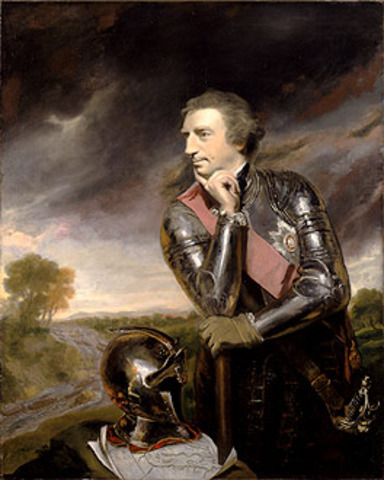
^ Amherst by Joshua Reynolds
Unlike the French traders the natives had dealt with earlier, their new neighbors were thought of as violent crooks and racists who saw the Natives as savages, ignorant of the world. The natives would be welcomed with open arms under the French but under the Brits they were now welcomed with physical abuse, “cold looks and harsh words”. These new neighbors also ignored the established borders and began taking over native land.
The French Urge the Uprising
French fur traders were believed to have been spreading rumors about their rival British traders in an attempt to instigate bad relations between the Natives and the British. They sought out the Natives and tried to convince them into warring against the British, even to the point of spreading lies and propaganda. Believing that the British were plotting against them, conspiracy to take their lands, strengthening their positions within their forts as well as refusing to grant access to firearmes.

^ Louis XV by Louis Michel van Loo
The French Canadians believed that King Louis XV of France had fallen into a slumber that had allowed the British to overcome France and its territories in Canada, that he had now awakened and had sent armies up the St. Lawrence and Mississippi “to drive out the intruders from the country of his red children”. These beliefs were passed out to the Natives. The French, mostly the trading companies but also possibly officers of the French crown, generously handed out clothing, provisions, weapons and ammunition to the Natives.
Delaware Prophets
The Lenape Natives initially lived along the Delaware River Valley in parts of New Jersey, New York and Pennsylvania –from which they received their more common name, Delaware. They became dependent on the colonies and became so involved in the trade of pelts and furs that they eventually killed off most of the mammals in their area –they soon grew impoverished and were forgotten as traders abandoned them for the Iroquois Natives to the north. Under the threats of poverty, conflict, alcoholism and disease, the Lenape numbers had dwindled from about ten to twelve thousand to about three thousand since contact was made with the Europeans.

^ Lenapehoking, the original Lenape territory
“-as small groups sold their land or were forced from it at various times. The scattered, decimated, and unorganized bands … soon gathered, or were gathered, as they had never been in pre-European times. The ‘towns’ that grew up in the river valleys of Pennsylvania in the early decades of the eighteenth century were not formed from homogeneous cultural units.”
Selling their lands, being forced out of others, and willingly abandoning others –they became refugees within their own land and would also retreat to the land of others. After the death of William Penn in 1718, he was succeeded by his sons Thomas Penn and John Penn –whom were involved in the infamous Walking Purchase of 1737 in which they brought forward a suspicious and possibly fraudulent copy of a land deed from 1686 that led to a large theft of land from the Lenape. The Penn brothers had arranged to have three trained runners sprint through a cleared route, covering about sixty-five miles in eighteen hours and winning them 1,200 square acres of land from the Delaware.
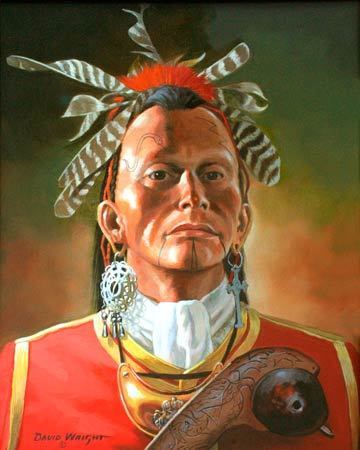
^ Delaware by David Wright
“They [Thomas Penn and John Penn] were used to an expensive life-style, but had no money. In their desperation, they contemplated ways to sell Lenape land to colonial settlers. The resulting scheme culminated in the so-called Walking Purchase. In the mid-1730s, colonial administrators produced a draft of a land deed dating to the 1680s. William Penn had approached several leaders of Lenape polities in the lower Delaware to discuss land sales further north. Since the land in question did not belong to their polities, the talks came to nothing.
But colonial administrators had prepared the draft that resurfaced in the 1730s. The Penns and their supporters tried to present this draft as an actual deed. Unsurprisingly, Lenape leaders in the lower Delaware refused to accept it. What followed was a convoluted sequence of deception, fraud, and extortion orchestrated by the Pennsylvania government that is commonly known as the Walking Purchase. In the end, all Lenapes who still lived on the Delaware were driven off the remnants of their homeland under threats of violence.“ – Steven Harper

^ Walking Purchase
The refugee Lenape villages that had arose from this displacement are believed to have been an important component that led to the French and Indian War and the surge of revolutionary ideas among the Lenape Delaware Natives. One of these revolutionaries was a man from the Delaware named Wangomen, who believed that the great creator spirit, Gichi-Manidoo, had chosen him as a messenger. Wangomen, also known as the Assinisink Prophet, was visited by a great buck during a hunting trip that conveyed the message that by abandoning the old ways, the Natives had placed themselves in this difficult situation. The great creator spirit, Gichi-Manidoo, let him peer into the heavens where he saw that there were three heavens –one for Natives, one for ‘Whites’ and one for ‘Negroes’. The ‘Whites’ were ill-treated in their heaven, as punishment for their abuses against the Natives, for taking the promised land away from them and for their enslavement of the ‘Negroes’.
Another Delaware man named Papoonan, had a vision while mourning his father’s death –the great creator spirit, Gichi-Manidoo, was offended by the way that the Natives had abandoned the old ways. Papoonan was a supporter of Natives purifying themselves in the old ways of their forefathers and for them to denounce the use of alcohol. Unlike the other prophets he preached peace, coexistence, the sharing of resources and also accepted some of the teachings of the Moravian Christian missionaries
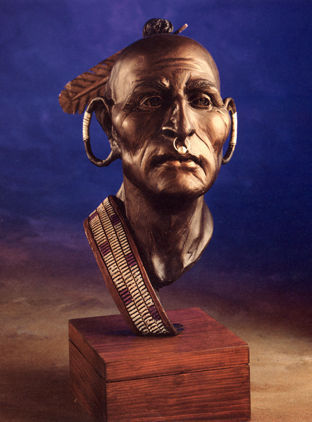
^ Neolin, the Delaware Prophet
There was yet another man from the Delaware tribe named Neolin, meaning “the enlightened”, in this story he plays the greatest significance. Neolin traversed the spirit world for days before reaching three forks in the road, from both the wide and the narrow roads a great fire arose from the ground which forced him to turn back. On the third path he encountered a marvelous white mountain in which he saw a woman of radiant beauty that instructed him to strip himself of all that he has and to purify himself in a nearby river. After purifying himself he met with the great creator spirit, Gichi-Manidoo, who gave him a guideline for the Natives to follow. The Natives must refrain from drinking, be married to one woman, not covet their neighbors’ wife and not to fight with their fellow brethren.
That the land in which they inhabited was given to them by him, reminding them that they lived before the French and English had arrived and didn’t need their assistance. They hunted with bow and arrow without need of firearms. That now they had become dependent on the whites, for his children (the Natives) to send the whites back to the homes that he has given them, across the ocean. To “drive off your lands those dogs clothed in red who will do nothing but harm”. He sought to purify his followers, urging them to rid themselves of all European goods and return to the lifestyle of their ancestors. Though he had many followers, the idea of tossing aside their arms was too much for some Natives to comply with. Nevertheless, Neolin became yet another force swaying the Natives against the ‘Whites’.
“By so doing, and by strictly observing his other precepts, the tribes would soon be restored to their ancient greatness and power, and be enabled to drive out the white men who infested their territory. The prophet had many followers. Indians came from far and near, and gathered together in large encampments to listen to his exhortations.” – Chapter VII, The Conspiracy of Pontiac and the Indian War after the Conquest
Chief Pontiac

^ Pays d'en haut, “the upper country”.
Neolin’s most famous follower was Pontiac (Obwandiyag), a wise Ottawa War Chief and head of the earlier mentioned ‘Council of Three Fires’; he sided with the French during the Second Fox War and the French Indian War (against the British). Pontiac foresaw the British threat and the inevitable conflict that would arise between them so he rallied Natives to his side by presenting a war-belt that he claimed was given to him by his “Great Father, the King of France [Louis XV]”, supporting their proposed war.
Pontiac also preached about Neolin’s vision of a future free from the ‘Whites’, who they could succeed in repelling back to their homelands. Pontiac had succeeded in rallying many native tribes that lived near the lakes Michigan, Huron and Erie –some directly under his command and others allied to his cause. Pontiac’s plan was inspired by one proposed by the Seneca chiefs Guyasuta (Kayahsota, “it erects a cross”) and Tahaiadoris in 1761, but many of the Natives didn’t join them and the British were tipped off. Pontiac was able to rally most of their neighboring tribes to his plan. The idea was to begin the offensive with a well-organized and coordinated assault on the British occupied forts that lay near their borders. The Natives were to take possession of them as quickly as possible, preferably with guile and trickery –with their neighbors seeing how successful they were, they too would join them.
“-then, having destroyed their garrisons, to turn upon the defenseless frontier, and ravage and lay waste the settlements, until, as many of the Indians fondly believed, the English should all be driven into the sea, and the country restored to its primitive owners.” – Chapter VII, The Conspiracy of Pontiac and the Indian War after the Conquest
By this time Fort Detroit was already seen as somewhat of a capital in the region; a large, twenty-five foot high, well-fortified stockade holding light infantrymen, French and British fur-traders, and five artillery weapons (three mortars) that were in bad shape. The fort was at the far edge of the British frontier and boasted rich land, moderate climate and was abundant in wildlife and game. The taking of Fort Detroit would grant the Natives an advantage in the war as this was the strongest and most well defended British settlement in the area –as the war raged on ever eastward, this devil at their back would remain a thorn on the side of this rebellion.
“The garrison, which numbered one hundred and twenty men and eight officers, was composed of Gage’s light infantry, under the command of Major Gladwin”

^ Fort Detroit in 1763
On the first of May Pontiac and forty men enter Fort Detroit under the guise of performing the ‘peace-pipe dance’, but in actuality they were evaluating the enemy and the fort. While celebrating, the Natives spoke of their martial achievements –especially those against the English, which they would repeat again in the future.

^ Pontiac visits Major Henry Gladwin at Fort Detroit
Pontiac’s Speech: May 5th, 1763 or April 27th
On the fifth of May, 1763 Pontiac addressed a gathering of his ally Ottawa, Potawatomi and Huron (Iroquois).
“It is important for us, my brothers, that we exterminate from our lands this nation which seeks only to destroy us. You see as well as I do that we can no longer supply our needs, as we have done from our brothers, the French. The English sell us goods twice as dear as the French do, and their goods do not last. Scarcely have we bought a blanket or something else to cover ourselves with before we must think of getting another; and when we wish to set out for our winter camp they do not want to give us any credit as our brothers the French do. When I go to see the English commander and say to him that some of our comrades are dead, instead of bewailing their death, as our French brothers do, he laughs at me and at you.
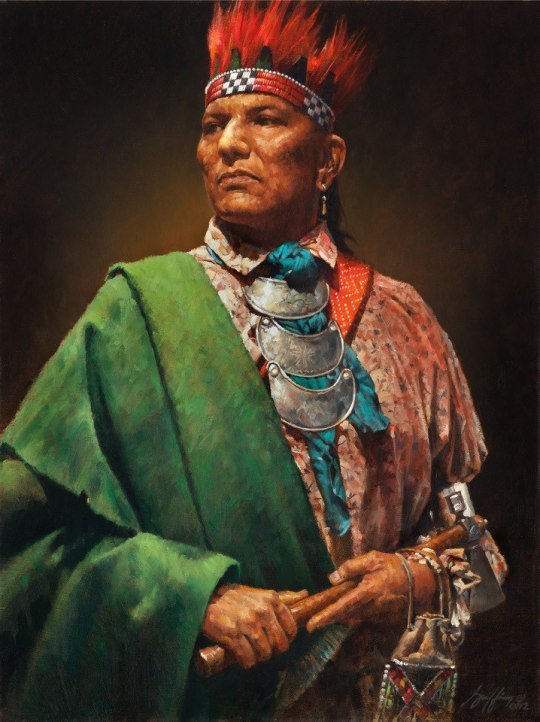
^ Pontiac by Robert Griffing
If I ask for anything for our sick, he refuses with the reply that he has no use for us. From all this you can well see that they are seeking our ruin. Therefore, my brothers, we must all swear their destruction and wait no longer. Nothing prevents us: they are few in numbers, and we can accomplish it. All the nations who are our brothers attack them –why should we not strike too? Are we not men like them? Have I now shown you the wampum belts [beaded belts symbolizing an agreement, a treaty, peace or war] which I received from our great father, the Frenchman [King Louis XV]? He tells us to strike them. Why do we not listen to his words? What do we fear? It is time.” – Pontiac addressing a gathering of Ottawa, Huron, and Potawatomi
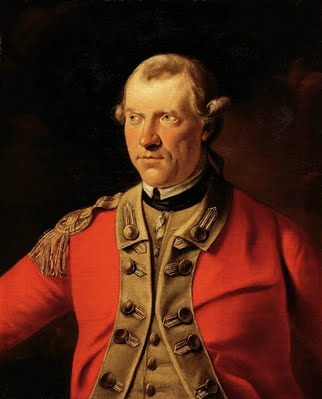
^ Major-General Henry Gladwin, portrait by John Hall
On the seventh of May Pontiac returned to Fort Detroit to enact their plan to gain admittance into the fort where they’d wield themselves with weapons concealed within; after being signaled they were to kill the fort’s inhabitants. However, the day before Major Gladwin was warned of Pontiac’s plan by an Ojibwe woman (believed to have been Gladwin’s mistress) so upon Pontiac’s arrival instead of seeing “lazy” and unorganized Englishmen, the garrisoned soldiers were at high alert, bayonet in hand.
“Perceiving at a glance that his plot was discovered, the great Ottawa chieftain made a few hollow professions of friendship, and without giving the signal, withdrew with his followers, gnashing his teeth in impotent fury.” – CHAPTER X, 1763
Side Note: John Rutherfurd’s Captivity, May 7th
A separate incident occurred in La Pinnierre, Canadians warned the Brits of an ambush set up by the Chippewa but Captain Charles Robertson had doubts. The crew ended up being ambushed, scalped and killed, all but a 17 year old Scotsman by the name of John Rutherfurd. John Rutherford joined the British officers in an attempt to map the rivers and lakes of the area but was captured and partly accepted by the Natives who later named him Addick, “White Elk”. He escaped in August and soon joined the Black Watch’ (The 42nd Regiment of Foot, an infantry regiment made up of Scotsmen). The Natives that ambushed them, the Saginaw Chippewa, were apparently en route to Fort Detroit before the ambush. If you’d like to read more, read his Journal here –> A Journal Of An Indian Captivity During Pontiac’s Rebellion In The Year 1763, By Mr John Rutherfurd
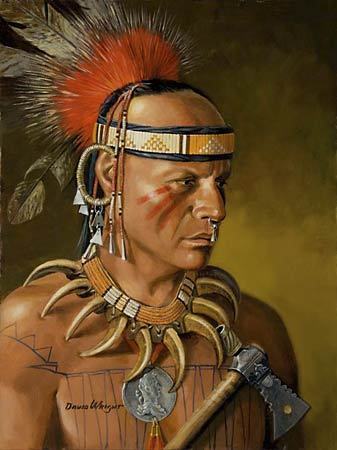
^ Ojibwa by David Wright
The Siege of Fort Detroit Begins
Pontiac returned to the barred gates of Fort Detroit on the ninth of May and again attempted to enact their ploy but the three hundred Natives were refused entrance. In response the Natives slaughtered the English that had dwellings right outside the fort’s walls and then laid siege to the fort, attempting to starve them into surrender. The inhabitants might’ve starved to death if it wasn’t for the fact that they had three weeks worth of provisions and were supported by the local “Canadians” that brought the British supplies under the cover of darkness.
“At this answer, the Indians threw off all farther dissimulation. Uttering horrid yells, they rushed into several English dwellings, built outside the palisades, and having tomahawked their wretched inmates, bore the reeking scalps to their camp, and spent the entire night in dancing and carousing. In the early dawn of the following morning, the rattling of bullets against the stockades told the garrison that the siege had begun.” – CHAPTER X, 1763
From here on I will cover the Pontiac-Guyasuta Uprising as well as the battles and sieges that occurred, the Native tactics used, the Native sport that inspired lacrosse, the famed Rogers’ Rangers and the attempt to infect Natives with smallpox tainted fabrics.
Keep reading
181 notes
·
View notes
Photo


From Tekken 2: A Fist Fight with God (神に挑む拳) by Hajime Kojiro,1995
13K notes
·
View notes
Photo
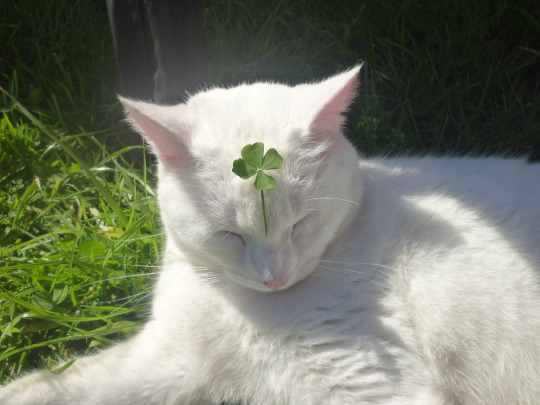
This is the lucky clover cat. reblog this in 30 seconds & he will bring u good luck and fortune.
1M notes
·
View notes



